Family name: Cymodoceaceae Vines
Synonym(s): [none]
Common name(s): manatee-grass family
*Number of genera/species: 5/17
List of genera records in GRIN-Global
fruit
Fruit indehiscent, acheneachene:
a dry, indehiscent, one-seeded fruit, with seed attached to pericarp at a single point
 , utricleutricle:
, utricleutricle:
a small, indehiscent, dry fruit with a thin wall (bladderlike) that is loose and free from the seed
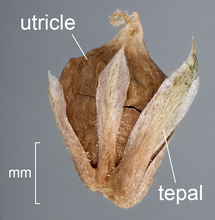 , or indehiscentindehiscent:
, or indehiscentindehiscent:
not opening on its own, as in a fruit
 , drupedrupe:
, drupedrupe:
(indehiscent drupe) a fleshy, indehiscent fruit with one more hard pits enclosing seeds; (dehiscent drupe) a fruit with a dry or fibrous to fleshy or leathery outer husk that early to tardily breaks apart (or opens), exposing one or more nutlike pits enclosing the seeds
 , 1.5–5 mm long, globoseglobose:
, 1.5–5 mm long, globoseglobose:
3D shape—more or less spherical
 to ovoidovoid:
to ovoidovoid:
3D shape—ovate , beakedbeaked:
, beakedbeaked:
a usually firm, terminal appendage, sometimes tapered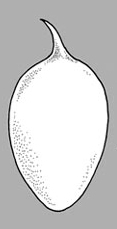 , sometimes enclosed in fleshyfleshy:
, sometimes enclosed in fleshyfleshy:
texture—fairly firm and dense, juicy or at least moist, and easily cut
bractbract:
a leaf-like or scale-like plant part, located just below a fruit (especially in grasses), flower, flower stalk, or an inflorescence
 (Thalassodendron), one seeded. In all genera, fruits are aggregateaggregate:
(Thalassodendron), one seeded. In all genera, fruits are aggregateaggregate:
fruit formed from a single flower with carpels several and distinct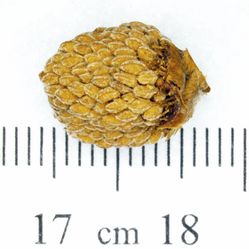 , but with frequent abortion of one or both carpels fruit may appear as simplesimple:
, but with frequent abortion of one or both carpels fruit may appear as simplesimple:
fruit formed from a single flower with one pistil, solitary carpel or several fused carpels
(Thalassodendron). Pericarppericarp:
fruit wall or fruit coat
black or brown, crustaceouscrustaceous:
texture—thin, dry, indurate, and brittle
, leatheryleathery:
texture—moderately thick, tough, and very pliable
, or stony, smooth or ridgedridged:
surface relief—raised, thick ridges, sharp edged or rounded, usually in a series that may cover the entire surface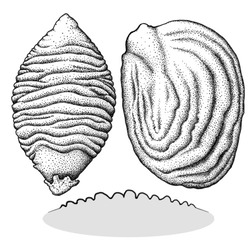 , if mesocarpmesocarp:
, if mesocarpmesocarp:
the middle layer of the pericarp, if divided into layers
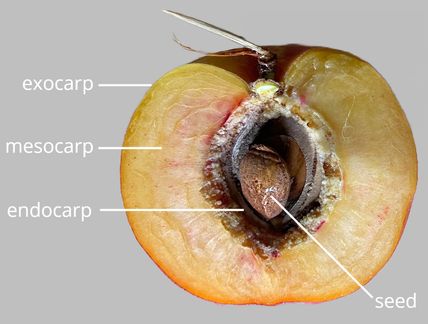 present then fleshyfleshy:
present then fleshyfleshy:
texture—fairly firm and dense, juicy or at least moist, and easily cut
. Genera identifiable based on fruit traits, see below.
Fruit traits by genus
Amphibolus: Fruit germinates almost immediately on the mother plant. The fruit base has four pectinate, spreading lobes (or bristles) that remain when seedling is released.
Cymodocea: Fruit semicircular to ellipsoidalellipsoidal:
3D shape—elliptic
, laterally compressedcompressed:
flattened; in grasses, used to denote compression (not necessarily flattened) either laterally or dorsiventrally
, with dorsaldorsal:
abaxial; the back of an organ; the side away from the axis (compare ventral)
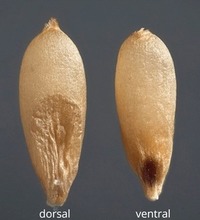 ridges and stony pericarppericarp:
ridges and stony pericarppericarp:
fruit wall or fruit coat
.
Halodule: Fruit ovoidovoid:
3D shape—ovate or somewhat compressedcompressed:
or somewhat compressedcompressed:
flattened; in grasses, used to denote compression (not necessarily flattened) either laterally or dorsiventrally
with stony pericarppericarp:
fruit wall or fruit coat
.
Syringodium: Fleshyfleshy:
texture—fairly firm and dense, juicy or at least moist, and easily cut
exocarpexocarp:
outer layer of fruit wall or pericarp, if divided into layers; note here used synonymously with epicarp
 is quickly shed and only the stony endocarpendocarp:
is quickly shed and only the stony endocarpendocarp:
the inner layer of the pericarp, if divided into layers
 remains in marine sediment, with differences in surface relief by species. Endocarpendocarp:
remains in marine sediment, with differences in surface relief by species. Endocarpendocarp:
the inner layer of the pericarp, if divided into layers
 is obliquely ellipsoidellipsoid:
is obliquely ellipsoidellipsoid:
3D shape—elliptic
or obovoidobovoid:
3D shape—obovate
, quadrangularquadrangular:
2D shape—four-sided, as in a square or rectangle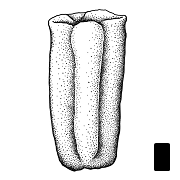 in transectiontransection:
in transectiontransection:
a cross section; representing a plane made by cutting across an organ at a right angle to its length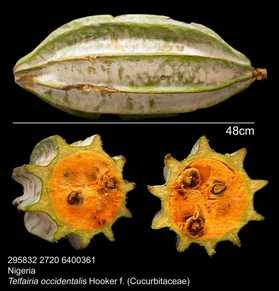 , with median ridge and bifidbifid:
, with median ridge and bifidbifid:
two-lobed or two-cleft (usually in reference to an apex)
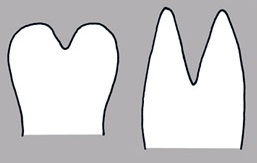 beakbeak:
beakbeak:
a usually firm, terminal appendage, sometimes tapered .
.
Thalassodendron: Fruit enclosed by a fleshyfleshy:
texture—fairly firm and dense, juicy or at least moist, and easily cut
bractbract:
a leaf-like or scale-like plant part, located just below a fruit (especially in grasses), flower, flower stalk, or an inflorescence
 and germinates on mother plant but lack lobes present in Amphibolus.
and germinates on mother plant but lack lobes present in Amphibolus.
Seed straight, compressedcompressed:
flattened; in grasses, used to denote compression (not necessarily flattened) either laterally or dorsiventrally
or tereteterete:
approximately circular in cross section; width and thickness approximately equal
 in transectiontransection:
in transectiontransection:
a cross section; representing a plane made by cutting across an organ at a right angle to its length , 2–10 mm long. Seed germinates on parent plant in Amphibolis and Thalassodendron. In the other genera, seed coat is thickthick:
, 2–10 mm long. Seed germinates on parent plant in Amphibolis and Thalassodendron. In the other genera, seed coat is thickthick:
having or being of relatively great depth
and hard, wrinkledwrinkled:
surface relief—shallow, irregular folds and furrows covering the surface; appearing overall though crumpled and then spread out , reticulatereticulate:
, reticulatereticulate:
surface relief—netted, raised walls or concave grooves forming a net-like surface pattern with flat, concave, or convex interspaces , ribbedribbed:
, ribbedribbed:
surface relief—wide, prominent, linear ridges that are generally rounded and longitudinally situated on the surface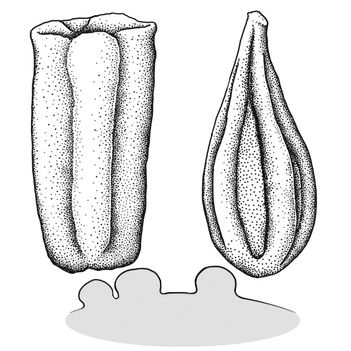 , or groovedgrooved:
, or groovedgrooved:
surface relief—linear depressions that may be single or form a series of grooves over the surface .
.
Embryo well developed, 2–3 mm long, macropodousmacropodous:
an embryo having an enlarged or elongated hypocotyl
, linearlinear:
(shape) long, narrow, and uniform in width; (of embryo) embryo is straight and much longer than wide
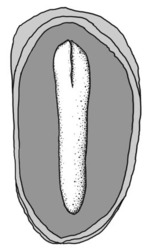 , curvedcurved:
, curvedcurved:
(of embryo) linear embryo is curved into an arch or horseshoe with the ends far apart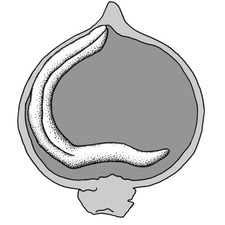 , filling seed coat. Endospermendosperm:
, filling seed coat. Endospermendosperm:
nutritive starch- and oil-containing tissue present in many seeds
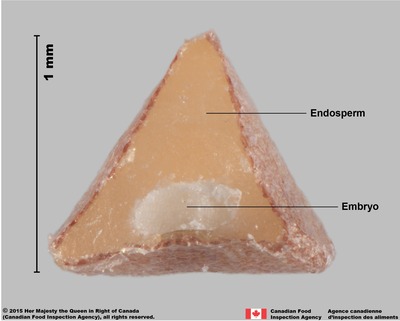 is absent instead the nutrients are stored in the large hypocotylhypocotyl:
is absent instead the nutrients are stored in the large hypocotylhypocotyl:
portion of the embryonic axis below the cotyledons and above the radicle
.
| Fruit | |
| Type | achene, utricleutricle: a small, indehiscent, dry fruit with a thin wall (bladderlike) that is loose and free from the seed  , or indehiscentindehiscent: , or indehiscentindehiscent:not opening on its own, as in a fruit  drupe drupe |
| Size range | 1.5–50 mm long |
| Shape(s) | ovoid, globoseglobose: 3D shape—more or less spherical  , ellipsoidellipsoid: , ellipsoidellipsoid:3D shape—elliptic , hemispherical |
| Texture | crustaceous, leatheryleathery: texture—moderately thick, tough, and very pliable , indurate |
| Surface relief | smooth or ridged |
| Color(s) | black, brown |
| Unique features | Indehiscent indehiscent: not opening on its own, as in a fruit  one-seeded, beakedbeak: one-seeded, beakedbeak:a usually firm, terminal appendage, sometimes tapered  , fruits with stony pericarppericarp: , fruits with stony pericarppericarp:fruit wall or fruit coat or endocarpendocarp: the inner layer of the pericarp, if divided into layers  . Or viviparous. . Or viviparous. |
| Seed | |
| Size range | 2–10 mm long |
| Shape(s) | straight |
| Surface relief | wrinkled, reticulatereticulate: surface relief—netted, raised walls or concave grooves forming a net-like surface pattern with flat, concave, or convex interspaces  , ribbedribbed: , ribbedribbed:surface relief—wide, prominent, linear ridges that are generally rounded and longitudinally situated on the surface  , groovedgrooved: , groovedgrooved:surface relief—linear depressions that may be single or form a series of grooves over the surface  . . |
| Unique features | Seeds germinate on parent plant. Or, seeds with thickthick: having or being of relatively great depth , hard seed coats, which are wrinkledwrinkled: surface relief—shallow, irregular folds and furrows covering the surface; appearing overall though crumpled and then spread out  , reticulatereticulate: , reticulatereticulate:surface relief—netted, raised walls or concave grooves forming a net-like surface pattern with flat, concave, or convex interspaces  , ribbedribbed: , ribbedribbed:surface relief—wide, prominent, linear ridges that are generally rounded and longitudinally situated on the surface  , or groovedgrooved: , or groovedgrooved:surface relief—linear depressions that may be single or form a series of grooves over the surface  , and with large, macropodousmacropodous: , and with large, macropodousmacropodous:an embryo having an enlarged or elongated hypocotyl embryos. |
| Other | |
| Embryo | well developed, 2–3 mm, macropodousmacropodous: an embryo having an enlarged or elongated hypocotyl , linearlinear: (shape) long, narrow, and uniform in width; (of embryo) embryo is straight and much longer than wide  , curvedcurved: , curvedcurved:(of embryo) linear embryo is curved into an arch or horseshoe with the ends far apart  , filling seed coat , filling seed coat |
| Nutritive tissuenutritive tissue: tissue within the seeds that nourishes the developing embryo; such as endosperm, perisperm, or chalazosperm in angiosperms; megagametophyte in gymnosperms |
endosperm endosperm: nutritive starch- and oil-containing tissue present in many seeds  lacking lacking |
Mainly tropical to subtropical oceans, occasionally occurring in warm-temperate areas.
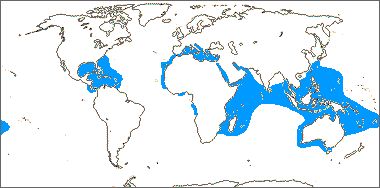
Distribution map courtesy of Angiosperm Phylogeny Website.
Baskin and Baskin 2021Baskin and Baskin 2021:
Baskin C and Baskin J. 2021. Relationship of the lateral embryo (in grasses) to other monocot embryos: A status up-grade. Seed Science Research 31 (3): 199-210. doi:10.1017/S0960258521000209; Beentje 2002Beentje 2002:
Beentje HJ. 2002. Cymodoceaceae. In: Beentje HJ and Smith SAL, eds. Flora of Tropical East Africa. Vol 52b. AA Balkema, Rotterdam Netherlands. 10 pp.; Dahlgren et al. 1985Dahlgren et al. 1985:
Dahlgren RMT, Clifford HT, and Yeo PF. 1985. The families of the monocotyledons: structure, evolution, and taxonomy. Springer-Verlag, Berlin. 520 pp.; Nooteboom et al. 2021; Flora of Australia 2021+Flora of Australia 2021+:
Flora of Australia. Australian Biological Resources Study, Canberra. Accessed January-May 2021. URL: http://www.ausflora.org.au; Kirkbride et al. 2006Kirkbride et al. 2006:
Kirkbride JH, Jr, Gunn CR, and Dallwitz MJ. 2006. Family guide for fruits and seeds, vers. 1.0. Accessed September 2020ndash;January 2022. URL: https://nt.ars-grin.gov/seedsfruits/keys/frsdfam/index.cfm .; Kubitzki et al. 1990+Kubitzki et al. 1990+:
Kubitzki K et al., eds. 1990+. The families and genera of vascular plants. 7+ vols. Berlin etc.; Orth et al. 2006Orth et al. 2006:
Orth RJ, Harwell MC, and Inglis GJ. 2006. Ecology of seagrass seeds and seagrass dispersal processes. In: Larkum AWD, Orth RJ, and Duarte CM, eds. Seagrasses: biology, ecology and conservation (pp. 111ndash;133). Springer, Netherlands.; Stevenson and Loconte 1995Stevenson and Loconte 1995:
Stevenson DW and Loconte H. 1995. A cladistic analysis of monocot families. In: Rudall PJ, Cribb PJ, Cutler DF, and Humphries CJ, eds. Monocotyledons: Systematics and Evolution. Royal Botanic Gardens, Kew.; Watson and Dallwitz 1992+Watson and Dallwitz 1992+:
Watson L and Dallwitz MJ. 1992+. The families of flowering plants: descriptions, illustrations, identification, and information retrieval. Version: 6th Accessed September 2020-September 2022. URL: delta-intkey.com
*The number of genera and species is based on Christenhusz and Byng 2016Christenhusz and Byng 2016:
Christenhusz MJM and Byng JW. 2016. The number of known plant species in the world and its annual increase. Phytotaxa 261 (3): 201ndash;217. https://doi.org/10.11646/phytotaxa.261.3.1, which may differ from the number of genera in GRIN-Global.